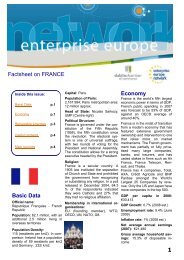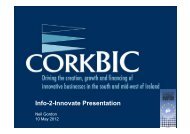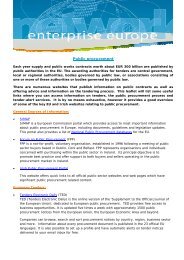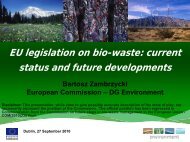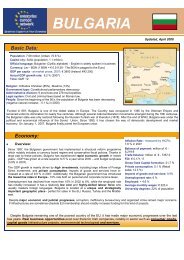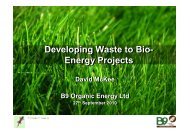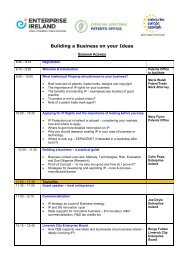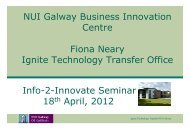Dr Jonathan Derham, Environmental Protection Agency. - Enterprise ...
Dr Jonathan Derham, Environmental Protection Agency. - Enterprise ...
Dr Jonathan Derham, Environmental Protection Agency. - Enterprise ...
Create successful ePaper yourself
Turn your PDF publications into a flip-book with our unique Google optimized e-Paper software.
Waste Pre-treatment – Opportunities & RoadblocksWaste to ResourceDublin 27 & 28 -09-10<strong>Dr</strong> <strong>Jonathan</strong> <strong>Derham</strong> BSc,PhD,MA(Mgt), PGeoOffice of Climate, Licensing & Resource Usej.derham@epa.ie
Primary EU Architecture of ChangeTaking Sustainable Use of ResourcesForward - A Thematic Strategy on thePrevention and Recycling of Waste[21.12.2005, Com(2005) 666 final]
Taking Sustainable Use of Resources Forward - A ThematicStrategy on the Prevention and Recycling of Waste, 2005n The long-term goal is for the EU to become arecycling society, that seeks to avoid waste andwhich uses waste as a resourcen Main Anticipated Impacts of Current StrategyllllllLess waste to landfillMore compost recovery from wasteMore energy recovery from wasteMore and better recyclingBetter prevention of wasteMore clarityn Lot of regulatory backdrop to this policy articulated in thenew Waste Framework Directive 2008/98/EC (notforgetting existing waste acquis)
New Waste Framework Directive 2008/98/EC (I)New or enhanced provisions:n Extended Waste Producer Responsibilityn Waste Preventionn Waste Prevention Programmesn Bio-Wasten Waste Hierarchyn Product Producer Responsibilityn Inspectionsn Enforcement sanctionsn Separate collections for waste streams
Commission Communication May 2010 – future steps inbio-waste management in the EU (Com(2010)235 final, 18.5.2010)n MS are legally bound to optimise the treatment of biowasten Minimum requirements for bio-waste management called forn Most significant benefits of diversion of biowaste from landfilllllAvoidance of GHG’sAvailability of good quality compost (improving soil quality)Availability of biogas (resource efficiency)n <strong>Environmental</strong> & financial benefits €1.5 to €7 billion(depending on effort)See also new consultation from Commissionon Sewage Sludge & Biowaste (21 Sept 2010,DG ENV C2/BZ/tb)
New Waste Framework Directive 2008/98/EC (II)n Product Producer Responsibility & WastePreventionlllllllManufacturers to accept producer responsibilitiesProduct / Eco-DesignLife-cycle analysisReduction/elimination of hazardous substances in productsPromotion of durable, re-usable & recyclable productsChanging in consumption patternsDecoupling waste generation from economic growth
New Waste Framework Directive 2008/98/EC (III)Early Actionsn By 2015 Separate Collections for –llllPaperMetalPlasticGlassn By 2020, recycling & preparing for reuse of 50% byweight of discarded household paper, plastic, metaland glassn By 2020, recycling, recovery & preparing for reuse70% by weight of discarded non-hazardousConstruction & Demolition waste
Structure of Waste LegislationWaste Lists,Waste Testing(33/2003),StatisticsCLASSIFICATION &REPORTINGFRAMEWORKDirective2008/98/ECSUBSTANCE /MATERIALPackaging, PCBs,RoHS, WEEE,Sewage Sludge,ELVs, etcTFS,BaselMOVEMENTPREVENTIONLCA, Eco-design, GreenProcurement, IPP, …TREATMENTIncineration,Landfill
National Policyn 1998 Waste Management Changing our Waysn 2002 Preventing & Recycling Waste: DeliveringChangen 2004 Waste Management: Taking Stock andMoving Forwardn 2006 National Strategy on Biodegradable Wasten Commissioning of International Reviewn Food Waste Regulationsn Proposed Government Waste Strategy
<strong>Dr</strong>aft Statement of Waste policy (DoEHLG, July 2010)MEASURESn Waste ManagementPlanningn Household WasteCollection Marketn Waste ManagementRegulationn Direction of Wasten Collection Servicen Civic Amenity Sitesn Obligation to use wasteservicesn Targets for residualwasten Waste Facility Leviesn Incinerator Bottom Ashn Recycling Targetsn Producer Responsibilityn Environment Fundn Green Economy
EPA MSW Pre-Treatment Guidance –A significant national step forwardPRRRERD
Why Pre-treat MSW ? - The Architecture of Justificationn It reduces environmental impact of residuals management facilitiesn Maximises value of key disposal infrastructuren It conserves resourcesn It is Policyn It is Lawn It is the right thing to don It reduces enforcement compliance burden / riskn Means to effectively manage predicted waste growthn It creates opportunity !
Current Trend & Future2008 positionESRI ISus Prediction for MSW growthIn reality these curves will not besmooth on account of stepped drop indisposal when, food was regs come in,and WtE incineration commences, etc
Some Current Waste Statsn MSW Recovery rate increased from 9% to 37% in 10years to 2008 (400% increase)n C&D waste down 24%n Industrial waste down 1%n Industrial Hazardous waste generation up by 5%n 43% BMW consigned to landfilln 49% commercial waste recovered in 2008n Only 26% household waste recovered in 2008n c.50% of WEEE exported for treatmentn c.50% of hazardous waste exported for recovery
Big Needs & Big Opportunitiesn Biowaste Treatmentn BMW treatmentn Residuals Treatment (Dirty & Clean MRFs)lllllBiodegradable elementMetalsMineralPlasticsGlass, etc ….n <strong>Dr</strong>y recyclables segregationn Co-location with landfills & other waste facilitiesn Co-location with IPPC facilities (preparing for re-use on sitevery attractive)
Constraints & Risks - 1n Delayed Policyl Leviesl Targetsl National Waste Planl Waste controll Green procurementn Access to Green Fundn Technological biasn Scale constraintsn NIMBY – NIMTO – BANANA – NORAn Regulatory prejudice & irrationalityn Markets & Standards
Constraints & Risks - 2Regulatory Issuesn Waste Activity or NotllArticle 5 of new Waste Directive 2008/98/EC – By-productsArticle 6 of new Waste Directive 2008/98/EC – End of Wasten Licence – Permit – Certificaten Review, new Activityn EIS (25,000tpa threshold)n Energy Regulatorn Feesn REACH, Packaging & Labellingn Animal By-Products Regulations (can these be combinedwith environmental permits?)
‘Opportunities’n Treatment of BMW in Residual Waste Streamn Dirty & Clean MRF technologies for quality outputsn Symbiosis & SynergieslllOne activities waste is another's resourceReproducible relationships with multinationalsCo-locationn Design to recyclelRecyclers feeding in at product designn Break the trans-global resources transport burdenllParticularly for secondary resources which seem to be collecting hugeair & sea miles on the way to recoveryUse what you have locally (primary or secondary)
Concluding Remarksn Waste pre-treatment requirements, Levies & new national wastepolicy initiatives, and new EU Waste Directive will be key driversn Green Public Procurement - ‘Moving the Market’ (DoEHLGMay 2010), and Green Growth in the EU 2020 Strategyn Visit the EPA National Waste Prevention Programme pages onthe web site. Lot of useful information and resources oninfluencing & changing behaviourn Further developments of EU waste diversion/prevention policyexpectedn Further use of material standards will be very helpful to industryand regulatorsn Regulation is creating opportunity; however regulatory burdensfor new enterprise in waste are not to be underestimated. Thereis a need to ‘enterprise proof’ the regulatory environment.
Thank you !<strong>Jonathan</strong> <strong>Derham</strong>j.derham@epa.ie




